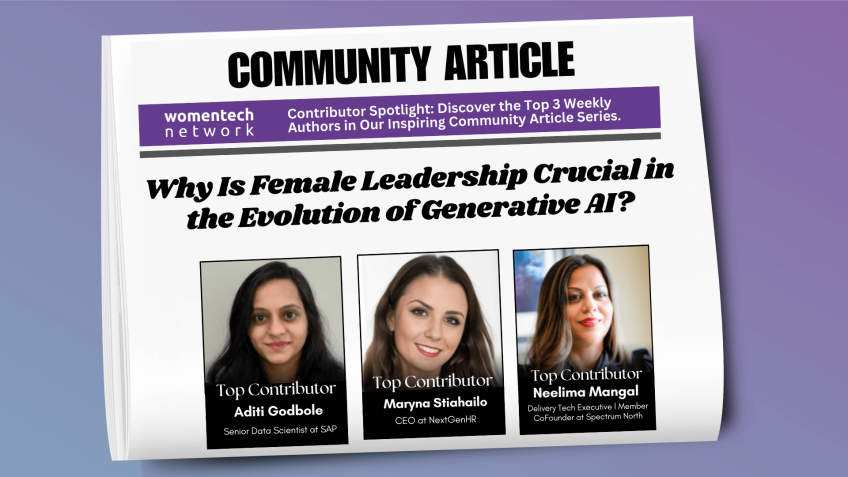Advancing Medical Research with Natural Language Processing by Jennifer Glenski
Advancing Medical Research with Natural Language Processing & AI: An Introduction
In today’s increasingly digital world, the intersection of AI and healthcare provides rich opportunities to advance medical research. As a data scientist and AI enthusiast with a decade-long experience, I would like to share a few examples of how AI is not only contributing to public good but also revolutionizing the healthcare sector.
AI For Good in Healthcare
AI is increasingly being leveraged to provide solutions in healthcare, from detecting diseases to analyzing large portfolios of medical research. The promise and potential of AI in healthcare are vast, encompassing a wide range of applications and opportunities to do good in the world.
Case Study: AI & NLP in Medical Research
My experience in developing AI for public good includes working on a project aimed at using natural language processing (NLP) to advance medical research. With millions of clinical studies and medical research papers in various research portfolios, it is beyond human capacity to manually read, categorize, and analyze them in a reasonable timeframe. The solution was an AI and NLP-based tool, which can effectively analyze, summarize, and classify research studies and papers.
Behind the Tech: AI & NLP Tools
- Pretrained Language Models (PT): Used to understand the meaning of language in text by using the surrounding text as context.
- Term Frequency Inverse Document Frequency (TF-IDF): Reflects how important a given word is to a document in a collection. Filters out common terms and identifies significant words that can guide research direction.
- Word Embeddings: Maps words or phrases to a corresponding vector of real numbers, aiding word prediction, similarity calculation, and semantics understanding.
The implementation of this toolset enabled us to identify key trends, novel research opportunities, and gaps in the field of medical research, helping to shape funding policies for the federal government which is a large funder of medical research in the United States.
Other Formidable Examples of AI in Healthcare
The application of AI stretches across various fields in healthcare, of which a few key ones are:
1. Automated Retinal Disease Assessment (ARDA): led by Dr. Lily Peng, uses AI to detect lesions in retina that can cause blindness due to diabetes. It is currently being evaluated in the US and other countries, aiming to make specialized eye care low-access areas more accessible.
2. Massachusetts General Hospital's Partnership with NVIDIA: Implemented AI-powered machines for faster testing and diagnostic capabilities, with the AI models trained on billions of medical images in radiology and pathology to identify diseases.
3. Fitbit's AI Algorithms: Developed to detect signs of Atrial Fibrillation (AF) which can lead to high risk of stroke, blood clot, and heart attack.
A Positive Impact on Patients' Lives with AI
The focus of AI has gradually shifted from optimizing business processes and automating household activities to making a significant impact on the healthcare sector. As AI continues to evolve, the number of ways to use AI in healthcare to tackle global health issues is growing too. There are still many opportunities and areas to be discovered, overall contributing to a positive impact on patients' lives.
In conclusion, the potential of AI in healthcare is immense. With continuous research and development of AI and machine learning technologies, we can expect more groundbreaking applications that will revolutionize the healthcare industry and medical research in the future. Please feel free to connect on LinkedIn for more exciting discussions on the impact of AI in healthcare. Enjoy the rest of your day!
Video Transcription
Hello, welcome to advancing medical research with N LP. We're excited to be here today and chat about a few ways that A I is helping advance public good in the healthcare space. So to begin, we'll start off with a little bit of an introduction.We'll look at a case study of medical research in natural language processing. We'll look at a couple more examples of A I and health care and close out with a summary. So first a little introduction, I have about a decade's experience of ex of data science and A I experience and I'm passionate about women in tech organizations. So I'm very happy to be speaking today. Also enjoy being involved with organizations such as Anita b.org and Teens in A I and I have experience in health care, government and other public sector initiatives for trying to use A I to promote public good. We know that A I is increasing at a rapid pace. There are many new applications and systems out there and there's a lot of interest around A I. And so what I try to do is use those new technologies to help make a positive impact. So a little bit of an overview for A I for good in health care. There's a lot of different applications and we'll look at some today ranging from detecting diseases to classifying medical imagery to analyzing large portfolios of medical research at a scale that wouldn't be possible.
Otherwise, manually, there's a wide variety of applications that can do good in the world and we'll see that there are just as many in just healthcare alone. So to start off, let's take a look at a case study that I was involved with for advancing medical research using natural language processing. So a little bit about the context, my team was working with research scientists who wanted to identify trends and gaps in portfolios of medical research. This was during the height of the pandemic in 2021. So I helped lead a product development team to build a suite of natural language processing tools for the government to analyze these different portfolios of medical research on a given topic. Our customer wanted to identify trends and gaps in the portfolio of medical research to identify key areas of funding in the next few years. So our goal then was to eventually advance medical research in critical areas including oncology, mental health, suicide prevention, exposure to hazards and traumatic brain injuries. The problem is there are millions of clinical studies and medical research publications that make up the various research portfolios.
That's too many for a team of researchers to manually read, categorize, summarize, analyze and all the eyes in any reasonable length of time. So they needed help and they needed a new solution that didn't rely on just human hours to do this work. That's where my team came in. My team's solution was to build A I and natural language processing models to analyze, summarize and classify research studies and papers so that our customer could get a better view and understanding of the entire field of research as a whole without having to read all the 100 millions of papers.
We built our A I and natural language models in Python. And we used be T language models. We pre trained language models. We use something called term frequency inverse document frequency word embeddings and more so be T as I mentioned is a pre trained language model from Google that understands the meaning of language in text by using the surrounding text as context term frequency inverse document frequency is a calculation that reflects how important a given word is to a document in a collection or cor that's another word for a collection of documents.
It's a way to filter out common terms such as the or we and identify the important words in a corpus such as genomics for our oncology. Research portfolio word embeddings or word vector organization is a methodology in natural language processing to map words or phrases from vocabulary to a corresponding vector of real numbers, which is then used to find word predictions and similarities and semantics. We successfully built and implemented this tool set in eight months and we were able to identify key trends, novel research opportunities and gaps in the field of re research related to strategic goals and influential institution and researchers. So if you think about a given area, say you wanna become more published in genomics and you wanna fund research in genomics who would be the key researchers to reach out to or perhaps the institutions to partner with that are strong in these areas. Those are some of the findings that we helped uncover for our customer. The tool can be applied to different fields of research as well to inform research funding policies over the next few years. And since the federal government is a large funder of medical research here in the United States, these tools and funding policies can make a significant impact in advancing medical research, which is pretty exciting stuff and it's something that I'm really glad to have been part of.
So next, I wanna share a couple other case studies and examples of A I and healthcare cause. There's just so much that's so exciting as Doctor Lily Peng says, the bigger promise of A I and health care is to make good care accessible to good people or to more people, sorry to everyone. And one way that she's doing that is by working on preventing blindness with AG so doctor Lily pen leads the team behind automated retinal disease assessment or A, which uses A I to help healthcare workers detect diabetic retinopathy, which are lesions in the back of the retina that can result as a complication of diabetes.
If undiagnosed and untreated, it can cause blindness. A large team of ophthalmologists helped train the A I model by manually reviewing and labeling over 100,000 retinal scans is currently being used in India and the European Union and is being evaluated in clinical studies in the United States and Thailand. The team's goal is to ultimately make available across the globe, especially in areas that have lower access to specialist eye care. Massachusetts General Hospital is another example using A I in health care. They partnered with NVIDIA to implement A I powered machines to facilitate faster testing and diagnostic capabilities. The A I models train on more than 10 billion medical images in radiology and pathology to identify diseases. So we can see that, you know, identifying classifying images.
It is a popular application in A I and in health care that image classification is particularly useful in detecting diseases. Fitbit developed A I algorithms to detect signs of atrial fibrillation or A FB, an irregular heart rhythm that can increase the risk of stroke, blood clots and heart attack. Adults over the age of 40 have a 25% or one in four chance of developing A FB A FB is treatable and often has no noticeable symptoms. So it's important to identify and treat it early. Fitbits. ECG takes a spot check approach which allows users to screen themselves for possible a FB and record an ECG trace to review as a health care provider at a later time. Fitbit's newer algorithm analyzes a person's heartbeat over time while they're resting to detect signs of a FB as well. The key piece is that fitbit can monitor a person's heartbeat when they're sleeping or very still, which is when signs of a FB are easier to detect. The goal is to help reduce the risk of potentially life threatening events like strokes or heart attacks and ultimately improve overall health.
So as we've seen, there are different ways to use A I in the health care industry to tackle global issues and there's a growing interest in, in using A I for Good. It's previously been used to optimize business processes or automate household activities where we're seeing a growing interest in using it in the healthcare domain. And this is just a sample of some use cases and case studies that we've seen recently. But there are so many more areas still to be discovered and so many opportunities to make a positive impact in patients or in people's lives using A I and health care. So with that, we have a couple of minutes left. If there were any comments or questions, you're welcome to ask that in the chat here. If you have questions later, you can also connect with me on linkedin. I'm always interested in chatting more about the exciting things that A I is doing in the world. So thank you all for attending and the next sessions will be starting in just a couple of moments here. So hope you have a great rest of your day.





